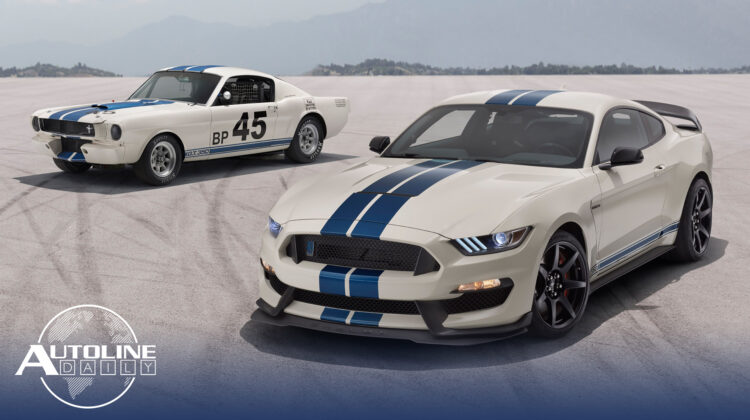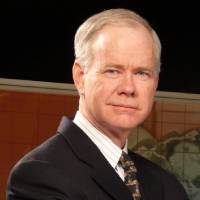
Follow us on social media:
Runtime: 10:05
0:07 Tesla’s Stock Soaring
0:42 USMCA Will Cost Automakers $3 Billion In Tariffs
1:57 BMW & Daimler End Car Sharing in North America
2:43 Daimler Hit With $20 Million Fine Over Recalls
3:35 Nissan’s Universal Powertrain Mounting System
4:51 Virginia Orders Electric School Buses
5:24 Mercedes Introduces New Electric Sprinter
6:42 CA Approves Self-Driving Delivery Vehicles
7:14 Honda Reveals Wild New Autonomous Concept
7:54 Limited Edition Shelby GT350 Heritage Package
8:35 Should Screens Be Mounted Portrait or Landscape?
Visit our sponsor to thank them for their support of Autoline Daily: Bridgestone.
This is Autoline Daily reporting on all aspects of the global automotive industry.
TESLA’S STOCK SOARING
Have you seen Tesla’s stock? It’s going through the roof, up $200 a share from its summer low. It closed at $393 a share yesterday and is knocking on the door of $400. A couple of years ago, the investment firm Baron Capital predicted it would hit $500 a share, which sounded crazy at the time. Now it doesn’t sound so crazy. Baron Capital also predicted it will hit $1,000 a share in 2020, which sounded crazy too, but maybe not as crazy as before.
USMCA WILL COST AUTOMAKERS $3 BILLION IN TARIFFS
The new USMCA trade agreement will cost automakers nearly $3 billion more in tariffs over the next decade says the Congressional Budget Office. That’s because to avoid tariffs, 75% of a vehicle’s content must come from the U.S., Canada or Mexico, up from 62.5% under NAFTA. There’s also mandates to use North American steel and aluminum. On top of that, 40-45% of vehicle content must be built by workers that earn more than $16 an hour. And some vehicles made in Mexico, with components mostly from Mexico and other regions, may not be eligible for U.S. tariff-free access. Here’s our Autoline Insight. While tariffs might go up by $300 million a year, that’s a drop in the bucket compared to the total volume of trade. The USMCA will help stop Mexican factories from importing Chinese components, doing some minor assembly, then exporting that as Mexican content. And the wage stipulation will protect U.S. jobs and could lead to higher wages in Mexico, either of which will be good for workers.
BMW & DAIMLER END CAR SHARING IN NORTH AMERICA
Automakers had high hopes for making bundles of money with car sharing services. But Daimler and BMW are pulling out of the car sharing market in North America. SHARE NOW, a joint venture between the two companies, said it will end operations in the U.S. and Canada due to volatility in the global mobility market as well as costs needed to sustain operations in North America. Let us put that in plain English for you. They were losing money and saw no way to turn it around. SHARE NOW offered services in New York, Seattle, Washington DC, Montreal and Vancouver and already stopped operations in five other cities, so this announcement isn’t a big shock.
DAIMLER HIT WITH $20 MILLION FINE OVER RECALLS
And speaking of Daimler, the automaker is being hit with a $20 million fine by the National Highway Transportation Safety Administration over its handling of recalls involving 1.4 million vehicles. The agency says the company did not notify owners in a timely manner and did not submit all reports. But Daimler may not have to pay the entire fine. It will pay $13 million over the violation but it will only have to pay the other $7 million if it does not comply with the agreement.
NISSAN’S UNIVERSAL POWERTRAIN MOUNTING SYSTEM
Traditional automakers, like Jaguar and BMW, are trying to build EVs on the same assembly lines as their ICE vehicles. But they often have to use off-line stations to install EV components. That’s why Nissan developed a Universal Powertrain Mounting System that can install 27 different powertrain combinations, including ICE, hybrid and pure electric. The entire powertrain is first mounted to a special pallet that can adjust for all the different combinations. It’s then placed under the vehicle it’s going into. After that, the system measures the car’s dimensions in real-time and robots are able to make micro-adjustments to the pallet, so it lines up with the vehicle. Nissan says the Universal Powertrain Mounting System will make it easier to offer customers a wider variety of powertrain options. But here’s our Autoline Insight. Automakers who dedicate assembly plants to making only EVs can remove 20-25% of the labor content. That’s why GM will dedicate its Hamtramck plant in Detroit to making only EVs, and why Ford’s plant in Cuautitlan, Mexico will only make Mach-E’s.
VIRGINIA ORDERS ELECTRIC SCHOOL BUSES
School buses in the state of Virginia are getting a whole lot greener. The state purchased 50 electric buses from Thomas Built Buses, a subsidiary of Daimler Trucks, as part of the initial phase of a bus replacement program. The buses are equipped with a total of 220-kWh of battery capacity and have a range of up to 134 miles. We think drivers and students alike, will appreciate not getting coal rolled as the buses pull away from the bus stop.
MERCEDES INTRODUCES NEW ELECTRIC SPRINTER
Mercedes introduced an all-electric version of the Sprinter. Called the eSprinter, its initially being offered as a panel van and it has the same maximum loading capacity of a Sprinter powered by a combustion engine. The eSprinter features an 85-kW electric motor and two battery options. A 47-kWh battery provides nearly 170 kilometers or about 104 miles of range. And a 35-kWh battery provides 115 kilometers or 71 miles of range. Mercedes did not announce the price, and we imagine it will be quite expensive. But with a number of cities around the world getting ready to ban vehicles with combustion engines, the eSprinter could find some willing customers.
Be sure to join us for Autoline After Hours this afternoon, as we look at the end of a year and the end of a decade. We’ll have consultant Paul Eichenberg, and Joe Langley from IHS Markit on the show to talk about where important trends are taking us. So join John and Gary at 3PM eastern time on our website, Autoline.tv.
CA APPROVES SELF-DRIVING DELIVERY VEHICLES
Self-driving vehicles took another step closer to becoming mainstream. California’s Department of Motor Vehicles will now allow light-duty autonomous delivery vehicles that weigh under 10,000 pounds on public roads for commercial and testing purposes. So, this means everything from modified passenger vehicles to purpose-built delivery pods will be able to transport food or other cargo. Companies can start applying for permits next month, which will vary depending on whether or not a backup driver is needed.
HONDA REVEALS WILD NEW AUTONOMOUS CONCEPT
Honda has a wild autonomous concept it’s bringing to CES. It believes that people want to both drive and be driven, so its concept has 8 driving modes between fully autonomous and manual driving and sensors inside the car try to guess the user’s intention to shift between these different driving modes. And when in manual mode, there’s no pedal to use, but rather you tap the steering wheel twice to start the car, push the steering wheel forward to accelerate and pull it back to slow down. Honda will have a simulation of what this driving experience feels like for anyone who attends the show.
LIMITED EDITION SHELBY GT350 HERITAGE PACKAGE
On the heels of the widely successful Ford v Ferrari movie, which is called LeMans 66 outside the U.S., Ford is coming out with a special package for the Mustang Shelby GT350 inspired by a car driven by Ken Miles. The Wimbledon White car with Guardsman Blue racing stripes was the first GT350 to hit the track in 1965, which Miles helped make an instant success. The Heritage Edition package carries over the same paint theme and also includes unique badging both inside and out. The package adds about $2,000 to the price of a Shelby GT350 or GT350R.
SHOULD SCREENS BE MOUNTED PORTRAIT OR LANDSCAPE?
Portrait or landscape? That is the question. Should you mount a big screen so that it’s vertical or horizontal? Tesla, the company that kicked off big screen mania, actually does both. In the Model S and X it’s portrait, in the Model 3 it’s landscape. Personally, we prefer a portrait. Because when using the navigation system, it’s much easier to see what’s coming up ahead. In landscape, it’s not as easy to see where you’re headed. And if you zoom out you lose too much detail. Streets and street names disappear. Different automakers are doing it different ways, so it could take some years before the car companies figure out what the public actually prefers. And we wonder if you have an opinion. From a usability standpoint, would you tell automakers to go portrait or landscape?
But that’s it for today, thanks for watching and please join us again tomorrow.
Thanks to our partner for embedding Autoline Daily on its website: WardsAuto.com

John McElroy is an influential thought leader in the automotive industry. He is a journalist, lecturer, commentator and entrepreneur. He created “Autoline Daily,” the first industry webcast of industry news and analysis.





